Introduction
Rotala is a relative newcomer to Florida and was first found in Coral Springs, which is located in Broward County, in 1996. The species has since established large—but mostly isolated—populations throughout the southern regions of Florida, and it is especially problematic in Lee and Collier Counties and along the state's west coast (Jacono and Vandiver 2007). This aquatic weed was introduced through the aquarium and water garden industry due to its attractive stems, leaves, and flowers and its ease of cultivation.
Rotala is listed as a Category II plant by the Florida Invasive Species Council, meaning the species has increased in abundance or frequency but has not yet drastically altered Florida plant communities (FISC 2023). The University of Florida, Institute of Food and Agricultural Sciences Assessment of Non-Native Plants in Florida’s Natural Areas classifies the species as “caution, manage to prevent escape” (2021).
Rotala produces extremely dense submersed populations and large thick mats that dominate the surface of the water. This greatly reduces ecosystem services, because oxygen levels within and light penetration through the water column are hampered. In addition, water flow is restricted because of the species' excessive growth. Many canals in south Florida are critically important components of the flood control system, and resource managers rely on these systems to quickly move stormwater. Because the rapid and vigorous growth of rotala inhibits water flow, the ability of infested canals to function properly in flood events is greatly hindered. As such, management of this aquatic weed is a major concern for resource managers.
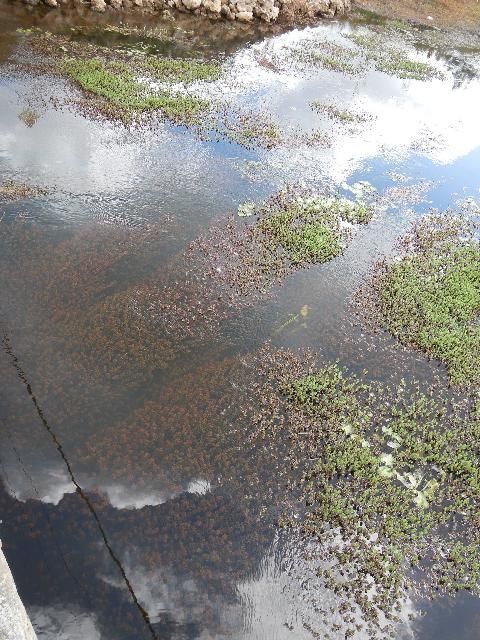
Credit: Lyn Gettys, UF/IFAS
Classification
Scientific Name: Rotala rotundifolia (Buch.-Ham. ex Roxb.) Koehne
Common Names: Rotala, dwarf rotala, roundleaf toothcup
Family: Lythraceae (loosestrife family)
Description and Habitat
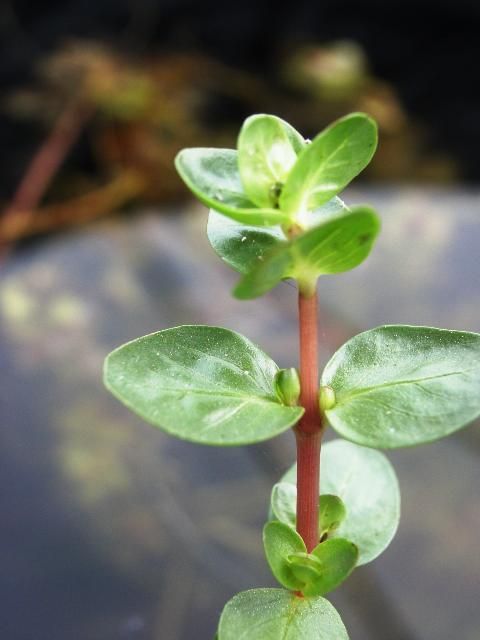
Credit: Lyn Gettys, UF/IFAS

Credit: Lyn Gettys, UF/IFAS
Rotala is an introduced freshwater aquatic weed that persists year-round in southern Florida. This species has both submersed (underwater) and emergent (out-of-water) forms, which differ in a number of characteristics. The small leaves (less than an inch long) are arranged in groups of two or three around both plants' hot-pink stems. However, emergent rotala has fleshy, bright-green, and rounded leaves, and submersed rotala has darker green or reddish leaves that are thin and lanceolate (sword-shaped). Growth habit differs between the forms as well. Low-growing populations of emergent rotala creep along shorelines and banks, with plant height rarely exceeding six inches. Submersed plants form tight, mounded colonies in water as deep as sixteen feet, but they eventually grow to reach the surface of the water, where they form dense mats that block light penetration and impede water flow. Rotala produces spikes of small, bright pink to fuchsia flowers, but flowering only occurs on plant tips that are aerial or emergent.
Rotala's Latin name of Rotala rotundifolia is very descriptive of the emergent form of the species—“Rota” means “wheel”, and “rotundifolia” means “round leaves”. However, the Latin name makes little sense if one sees only the submersed form of this weed, since plants growing underwater produce leaves that are sword-shaped. Rotala invasions in Florida are most common in the southern part of the state, and this weed is especially problematic in the waters of Florida's west coast. Rotala is a tropical species and is not considered cold-tolerant. However, emergent populations cultured for research purposes outdoors in Gainesville routinely die back after multiple hard freezes during winter, and then quickly regrow when spring arrives.
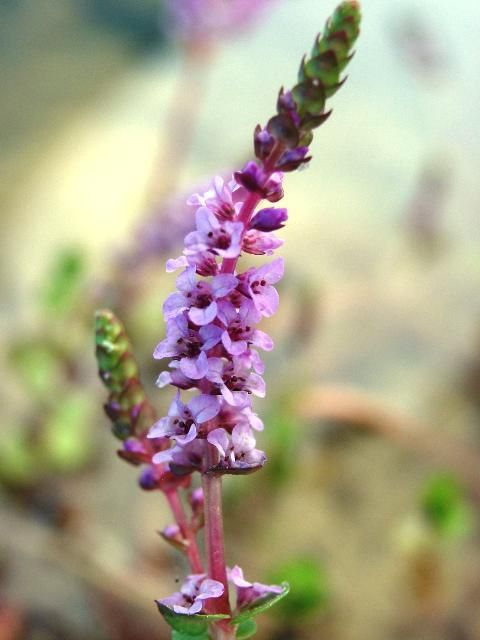
Credit: Lyn Gettys, UF/IFAS
Control
Herbicides
The search for herbicides to manage rotala has been ongoing since the species was first found out of cultivation. Early evaluations revealed that topped-out emergent growth can be “burned back” with foliar applications of glyphosate, but this does not result in long-term control. Submersed applications of endothall and flumioxazin do not cause measurable damage to the species, and diquat (at 400 ppb) provides only around 80% control.
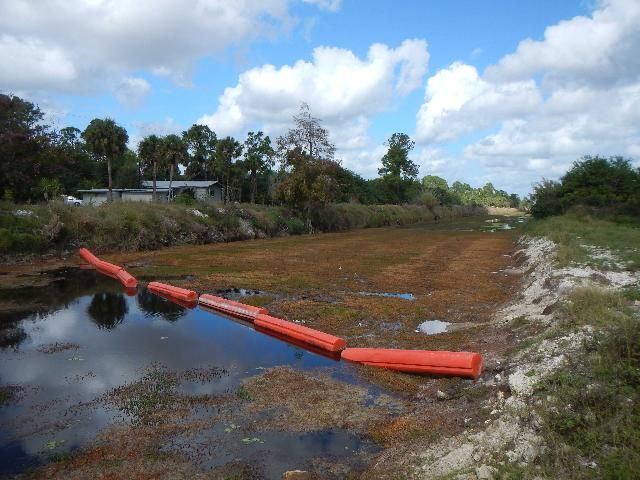
Credit: Lyn Gettys, UF/IFAS
Some submersed applications (for example, 2 ppm triclopyr, 2 ppm 2,4-D, 37 ppb fluridone) can result in total or near-total control of rotala (Della Torre et al. 2017). However, triclopyr and 2,4-D have the potential to cause serious off-target damage to economically important crops such as tomatoes and peppers, while fluridone applied at 37 ppb is not selective and would be expected to cause significant off-target damage to desirable aquatic plants in the treatment area. Della Torre et al. (2017) also reported that good control was achieved after foliar applications of bispyribac or imazamox at 1 or 64 oz/ac, respectively. Newer work has shown that rotala is extremely sensitive to very low concentrations of florpyrauxifen-benzyl; in fact, submersed rotala may be completely eliminated by as little as 6 hours exposure to 2.5 ppb florpyrauxifen-benzyl (Gettys et al. 2021).
Mechanical Harvesting
Although mechanical harvesting is used as a management tool to reduce a number of aquatic weed populations, employing this technique for rotala control is challenging for a number of reasons. Rotala is heavier than many submersed weeds, such as hydrilla, and this puts additional stress on machinery and necessitates more trips between the infested site and the offload location. Also, offloading harvested material onto the canal bank may be an effective practice when mechanical harvesting is used to control some submersed weeds, but it can actually spread populations of rotala along the canal bank because the species grows quite well as a shoreline plant. As a result, plant material should be transported far from the water or hauled to a landfill. In addition, rotala propagates mostly by vegetative means, so the fragments produced during mechanical harvesting may result in downstream spread of the species.
Biocontrol
A biocontrol insect has been successfully used to manage populations of purple loosestrife (Lythrum salicaria), which is a close relative of rotala that has invaded the northeastern United States. However, there are no biological control agents that provide effective control of rotala. Rotala is a problematic weed only in south Florida—at least at the time of this publication—and the expense associated with identifying and evaluating a biocontrol agent for this weed is not justified. Triploid grass carp, a generalist herbivore, has been evaluated on a small scale for rotala control, but there is no evidence that these fish actually eat the species thus far.
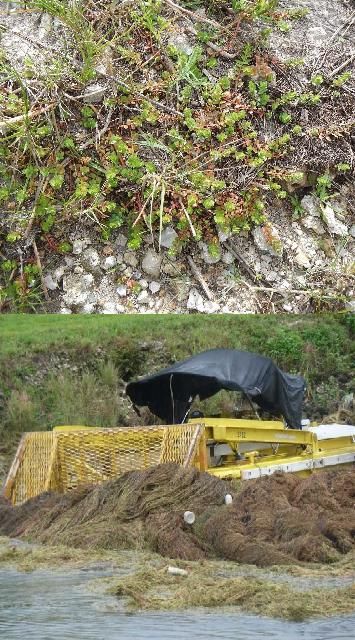
Credit: Lyn Gettys, UF/IFAS (above) and Ellen Allen/SFWMD (below)
Summary
Rotala is a new and problematic weed in southern Florida that causes significant problems for resource managers. Although mechanical methods can be used to manage rotala, this technique is expensive and can foster the spread of the species. Several aquatic herbicides provide good control of rotala, but the most promising candidate so far is florpyrauxifen-benzyl, which provides excellent control of submersed rotala at a very low dose (2.5 ppb) with very short exposure times (6 hours), which makes this herbicide well-suited for use in many of south Florida's infested canals.
References
Della Torre III, C. J., L. A. Gettys, W. T. Haller, J. A. Ferrell, and R. Leon. 2017. “Efficacy of Aquatic Herbicides on Dwarf Rotala”. Journal of Aquatic Plant Management 55:13–18. https://apms.org/wp-content/uploads/japm-55-01-13.pdf
FISC. 2023. 2023 FISC List of Florida's Invasive Plant Species. Accessed July 9, 2024. https://www.floridainvasives.org/plant-list/2023-invasive-plant-species/
Gettys, L. A., K. L. Thayer, M. A. Heilman, and E. M. van Goethem. 2021. “Effect of Florpyrauxifen-Benzyl Concentration–Exposure Time on Hygrophila and Rotala”. Journal of Aquatic Plant Management 59:79–84. https://apms.org/wp-content/uploads/japm-59-02-079-full.pdf
Jacono, C. C., and V. V. Vandiver Jr. 2007. “Rotala rotundifolia, Purple Loosestrife of the South?” Aquatics 29(1): 4–9. Accessed July 9, 2024. https://fapms.org/wp-content/uploads/2021/06/2007spring.pdf
University of Florida, Institute of Food and Agricultural Sciences. 2021. Assessment of Non-native Plants in Florida’s Natural Areas, Rotala rotundifolia. Accessed July 9, 2024. https://assessment.ifas.ufl.edu/assessments/rotala-rotundifolia/